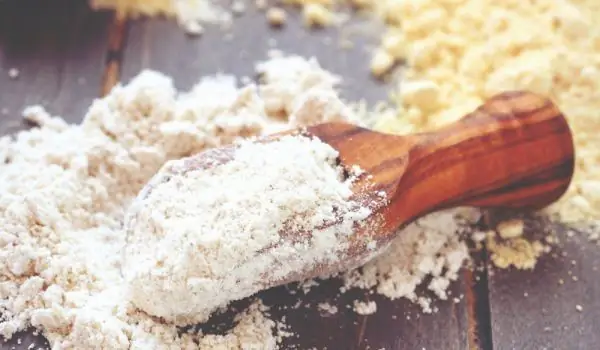2025 Author: Jasmine Walkman | [email protected]. Last modified: 2025-01-23 10:18
Flour has been known to people for millennia. In many countries it is considered the main food of the population and is present daily at the table. It is produced from wheat, oats, rye, corn, millet, rice, chickpeas, chestnuts, etc.. The process of obtaining flour itself consists of grinding the grains into powder.
The traditional processing consists in maximum removal of the shells of the grains and obtaining high quality white flour. In this way, however, the content of useful substances decreases and this process continues throughout all stages of production and storage of products. This loses a significant amount of micronutrients.
The end result is that common white flour of higher quality is much poorer in vitamins and minerals than dark and whole grain types of flour. They also reduce vitamins such as B1, B6, PP and the minerals magnesium, potassium, phosphorus, selenium and iron.
Wholemeal flour is obtained by grinding whole grains without removing any of them. These flours are more valuable from a biological point of view. They are rich in vitamins, minerals, cellulose and protein. But from a technological point of view, they are of lower quality, as they are less resistant to storage and poorer baking qualities.
From each grain can be obtained wholemeal flour by grinding in a stone mill.
The main factor that determines the degree of whole grain is the ash content - the higher it is, the more wholemeal the flour. And this is noted when writing the type of flour.
Type 1850 (for wheat), also called Graham - ground grain is not sifted;

Type 2000 is a wholemeal einkorn flour
Type 1750 whole grain rye
Type 1150 is a typical wheat flour
Type 500 is white wheat flour
The figure shows the ash content in the flour in percent. For example, flour type 1150 has a 1.15% ash content. A higher percentage means more of the skin, a darker color, more vitamins, minerals and enzymes.
The mass bread in our country Stara Zagora, Dobrudzha and Sofia is prepared from three main types of flour: type 500, 700 and 1150.
Rye flour type 1000 and type 1750 has a darker color, small volume, light porosity, sticky and moist environment. The protein composition of rye flour is almost similar to that of wheat flour, but, on the other hand, it has a higher content of essential amino acids (lysine and threonine), more own sugars and easily soluble polysaccharides and trisaccharides.

Cornmeal is rich in carbohydrates - up to 85%, and low in protein and amino acids and contains more fat (which makes it unstable for storage). Cornmeal bread has a rough, dense, inelastic and rapidly aging medium, with a small volume and cracked crust. Therefore, it is most often used as an additive to wheat flour, usually up to 15%.
Recommended:
Flour

Bread and water are things that human nature requires, Seneca said. As the main raw material for bread, flour is one of the most ancient products that man uses for his diet. Traditionally, bakery products are among the favorite foods of Bulgarians.
Einkorn Flour - Essence, Benefits, Application

Einkorn is a type of cereal that dates back to ancient times. Due to its more difficult processing and not so easy cultivation, however einkorn has long been one of the most common cereals. The oldest remnants of einkorn date back 18,000 years.
How To Prepare Chickpea Flour Yourself?

Chickpeas are extremely useful. It is rich in protein and works wonders for cell repair. The huge amounts of vitamin E and zinc in it improve the functions of the immune system, and the isoflavones contained in the flour protect the body from tumors.
What To Cook With Buckwheat Flour

The beneficial properties of buckwheat flour are mainly associated with its rich content of iron, calcium, potassium, phosphorus, iodine, zinc, magnesium, manganese, fiber and amino acids. Buckwheat flour is still not a commonly used product in our country, unlike in Russia.
Peanut Flour

Peanuts have been present in our lives for many years. We can consume them directly, in salads and dishes; in addition to cocktails or in the form of peanut butter, oil or flour. Known for its health benefits, peanuts are a favorite food of the majority of the population.

